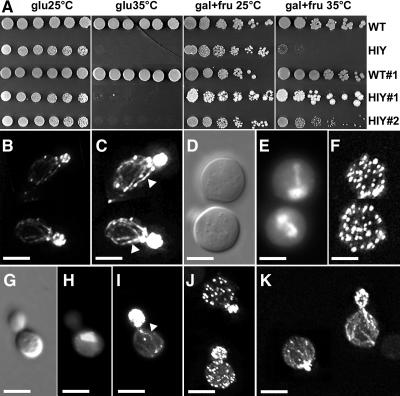Figure 5.
Suppression of the Yeast bniΔ bnr1Δ Mutant by AtFH6.
(A) AtFH6 expression suppress the temperature-sensitive defect of bniΔ bnr1Δ (HIY11) yeast. Serial dilutions of cultures of each transformant (bniΔ bnr1Δ mutant and wild-type K699) containing empty pYES2 (HIY11 and WT) or pYES2 AtFH6 (HIY#1, HIY#2, and WT#1) were spotted onto media lacking uracil but containing 1% glucose (glu) for repression or 1% galactose and 1% fructose (gal+fru) for induction and grown at permissive (25°C) or restrictive (35°C) temperature. HIY11 cells did not grow at 35°C, whereas HIY11#1 and #2 transformants grew at 35°C only in the presence of galactose.
(B), (C), (F), and (I) to (K) Projections of optical sections of yeast cells grown at 35°C in the presence of galactose and stained with fluorescent phalloidin, which binds to filamentous actin.
(B) Wild-type budding cells with polarized actin patches and cables.
(C) Image shown in (B) with contrast enhanced to make it easier to see actin cables (arrowheads).
(D) and (E) Large bniΔ bnr1Δ rounded cells visualized by differential interference contrast and fluorescence microscopy after DAPI staining of DNA, respectively.
(F) Enlarged bniΔ bnr1Δ mutants with randomly distributed actin patches.
(G) and (H) Suppressed HIY#1 budding cells expressing AtFH6 visualized by differential interference contrast and fluorescence microscopy after DAPI staining, respectively.
(I) Suppressed HIY#1 cells expressing AtFH6 with actin cables in the mother cell (arrowhead) and actin patches in the bud.
(J) In some suppressed HIY#1 budding cells, actin patches are still observed in the mother cells.
(K) WT#1 expressing AtFH6.
Bars = 5 μm.

